Yves here. Poland would likely agree with Henry Kissinger’s observation, “It may be dangerous to be America’s enemy, but to be America’s friend is fatal.” As John Helmer explains, Poland has a litany of grievances about American and NATO, including that the US is openly trying to turf out the current government, hasn’t pressed the EU for payment of at least some of the withheld subsidies in light of Poland being the first port of call for Ukraine refugees (Poland is in the EU’s doghouse for objecting to the ECJ having final legal say), and having to pay full freight for US weapons when NATO is not set up to protect Poland from the bad Russian bear. For more on the last issue, the second half of this article contains the translation of a lengthy, no-holds-barred interview of Polish army general Miecyslaw Gocul, who among other things was Poland’s former chief of General Staff, on the considerable deficiencies of NATO, particularly its command structure.
By John Helmer, the longest continuously serving foreign correspondent in Russia, and the only western journalist to direct his own bureau independent of single national or commercial ties. Helmer has also been a professor of political science, and an advisor to government heads in Greece, the United States, and Asia. He is the first and only member of a US presidential administration (Jimmy Carter) to establish himself in Russia. Originally published at Dances with Bears
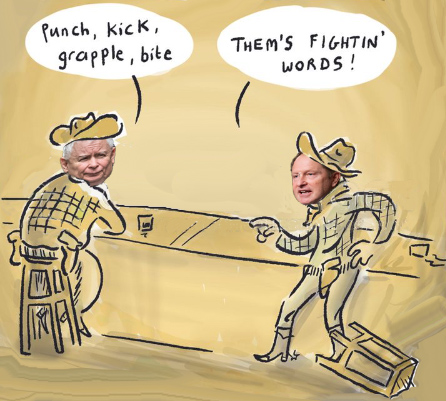
The Poles have always had a serious problem with their neighbours.
They have the Germans on their western flank, the Russians on their eastern flank, and inside their borders there used to be the Jews, but now there are the Ukrainians. In September 1939 there were about 3.3 million Polish Jews. Since February 24 of this year, the Ukrainians in Poland have come to the same number.
The war which the Polish government and military have been fighting against Russia is proving to be almost worthless politically to Law and Justice (PiS), the ruling party in Warsaw; and also to the Civic Platform (PO) and its allies, the principal opposition coalition (KO). The PiS was 15 percentage points ahead of the KO in the voter polls a year ago, 35% to 20%; the margin between them now is 11 points, 38% to 27%. The gains for each are close to the margin for statistical error.
Economically, the war is costing much more in public outlays for the refugees than the value of US and NATO arms flows and related war income. By the time Warsaw pays for its new US weapons, it will owe more than when the war started; and there is still no relief from the European Union funding freeze and penalties.
What’s to be done, the Poles ask themselves – and who’s to blame when they realise the answer is something between not much and nothing.
The principal American in Poland Ambassador Marek (Mark) Brzezinski, has recently called for regime change in Warsaw. He said it this way: “I look at the way we cooperate with the Polish government in a completely different way. We have been consistent in our commitment to security, democracy, values, the economy and people-to-people contacts. One is not subordinate to the other. And we can do several things at the same time. There is no doubt that we unequivocally support Poland in terms of security. There is also no doubt that our approach to the issue of Polish democracy is the same…The priority issues that we see in Poland are equal for us in terms of value. We have worked together as friends in each of these areas: security, democracy, the rule of law, the economy, people-to-people contacts. We are grateful to President Andrzej Duda for some of the actions taken. As President Biden said in Poland, each of us has a job to do. In the Biden administration, we are also working on our democracy and the rule of law. ”
What the Polish audience understands Brzezinski is saying is that “democracy and the rule of law” mean the replacement of the PiS and its leader, Jarosław Kaczynski. By Polish “democracy” Brzezinski doesn’t mean Lewica, the coalition of Poland’s left parties, which are currently drawing 10% in the polls. The US, according to Brzezinski, is as ungrateful to President Duda for most of what he and the PiS are doing as the US is grateful for “some”. As for the Polish economy, it is going to pay $14.1 billion for its new F-35 fighter aircraft, Abrams tanks and Patriot missiles without discounts or domestic production offsets. By “people-to-people” contacts, what the US ambassador means is his special relationship with the sworn rival of the PiS in next year’s campaign, Rafał Trzaskowski; he is the Warsaw city major since 2018 and PO presidential candidate in 2020, when Duda narrowly defeated him.
For more on Duda’s trip to Kiev and his speech to the Verkhovna Rada on May 22, read this. For the March 15 meeting which Prime Minister Mateusz Morawiecki and PiS leader Kaczynski say they held in Kiev with Ukrainian officials, along with the Slovenian and Czech prime ministers, click to read the backfile.
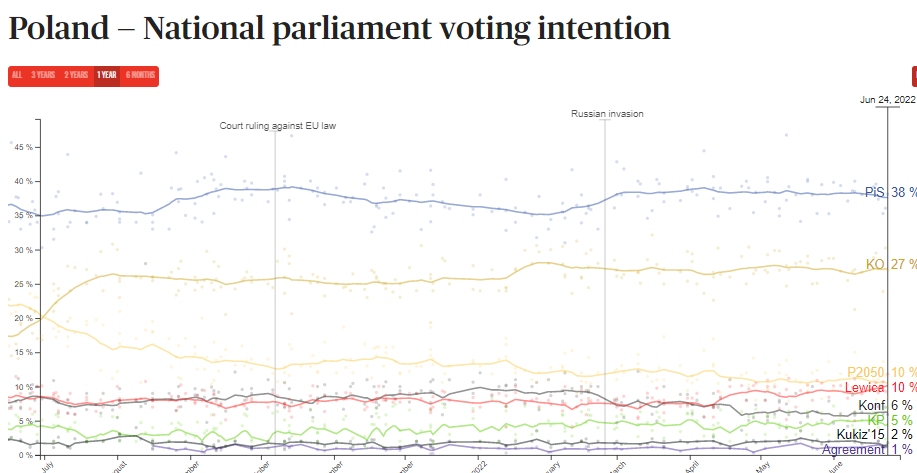
For a summary of the Polish political lineup and the party acronyms, click to read. For the poll tracking and enlargement of the chart, click to view.
Warsaw political analyst Stanislas Balcerac, a political independent, believes the PiS is likely to lose next year’s election. That, he says in a newly published article in Warszawska Gazeta, is because it lacks majority voter support, and will be unable to recover it so long as the eastern Polish regions, where the PiS strength was demonstrated in the presidential election, remain the main source of PiS voter support. Balcerac’s recommendation is that Duda and Morawiecki invoke the emergency powers of the Polish Constitution and postpone the election.
MAIN CITIES OF POLAND
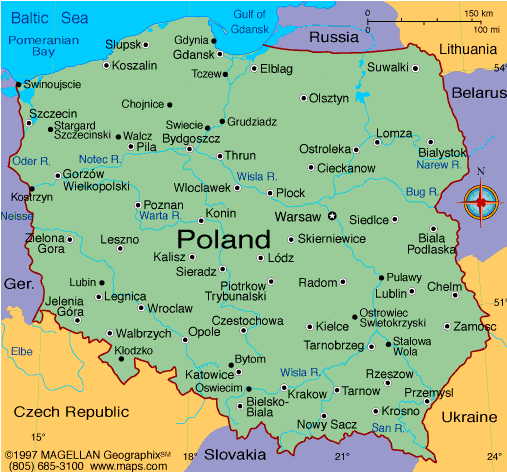
EAST-WEST DIVIDE — HOW THE POLISH REGIONS VOTED IN THE 2020 PRESIDENTIAL ELECTION
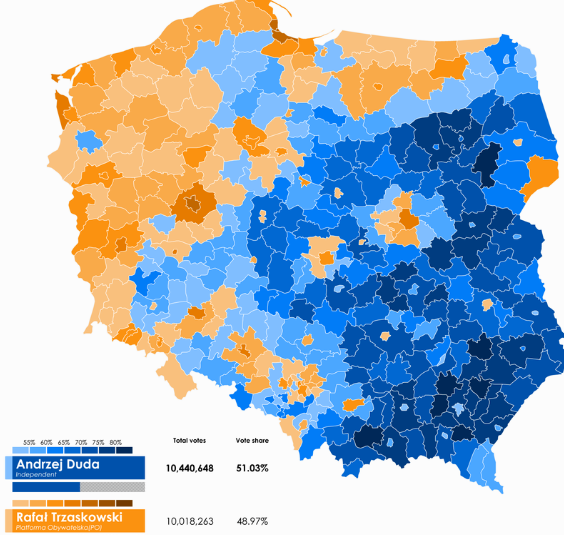
Source: https://en.wikipedia.org/
For the eastern vote for PiS, read this.
CONCENTRATION OF UKRAINIANS IN THE POLISH CITIES
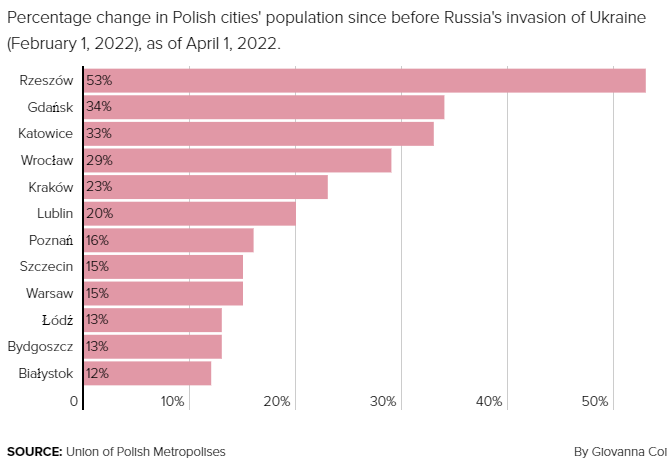
Source: “Urban hospitality -- rapid growth, challenges and opportunities”, Report on Refugees from Ukraine in the largest Polish Cities, Centre for Analysis and Research of the Union of Polish Metropolises, April 2022.
Balcerac writes: “Although the war has established itself in our country for good, it has not changed the attitude of the opposition. Instead of supporting the government in strengthening the country’s defenses, they are engaged only in attacking it. Poland is already involved in the war in Ukraine as a logistics platform. It also has a war on its border with Belarus. A front-line country involved in a war should have a state of emergency or martial law on its territory, so that the state can control its territory and fight against diversion and disinformation. According to Article 228 of the constitution of the Republic of Poland, during a state of emergency and within ninety days after its end, the term of office of the Sejm [Polish parliament] may not be shortened, a nationwide referendum may not be held, elections to the Sejm, the Senate, local government bodies and elections of the president of the republic may not be held, and the terms of office of these bodies shall be extended accordingly.”
ARTICLE 228 OF THE POLISH CONSTITUTION
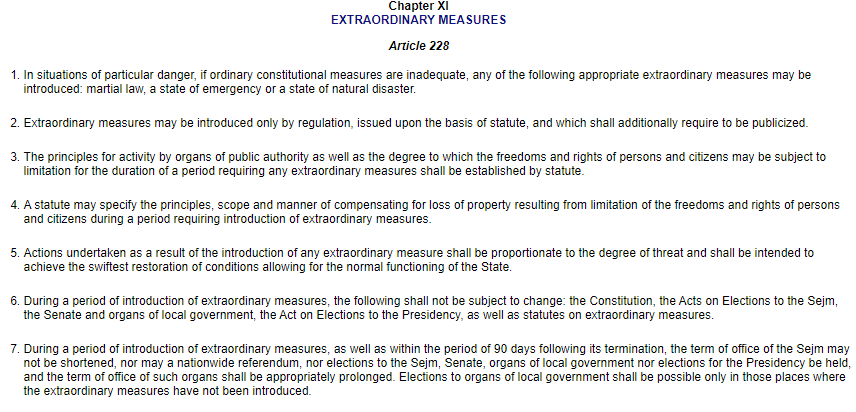
Source: https://www.sejm.gov.pl/
Balcerac continues: “For comparison with Poland, Lithuania introduced a state of emergency not on the 3-kilometer strip near the border with Belarus, but on the entire territory of the state. What impact does the war have on the behavior of Polish voters? In the latest electoral polls, PiS gets 34.2% of the vote (according to the United Surveys poll for Virtual Poland), 34.5% of the vote (according to IBRIS for Rzeczypospolita), 36% (according to Kantar for TtvN ) and 38% (Estimator poll for DoRzeczy.pl).”
“We don’t see too much of a war bonus here; that’s to say, there is no wall of voters backing he PiS government and the state’s defense policy. ‘We must win this war,’ Jarosław Kaczyński said in mid-June in Gazeta Polska. But if a front-line country like Poland is to win this war, the government must have strong support from its citizens. 34% percent of the vote does not give such support, and this is a worrying sign before the 2023 elections. Part of the media has already begun to carve up the carcass of the bear and speculate about the loss of power by the PiS. ‘With the PiS there is no chance of independent rule. The opposition has a chance if it would be able to form a majority coalition,’ wrote the weekly Wprost on June 22. The problem is, however, that if the PiS were to lose its parliamentary majority in the 2023 elections and seek a coalition, it would have to seek compromises with the PSL [agrarian Polish People’s Party], the Left, or the Confederation [far right]. Except that according to the IBRIS poll, the Confederation would have trouble getting over the 5% electoral threshold. However, in the face of war with Russia and in the current party system in Poland, it must be said that the capacity of the PiS to form a coalition with a majority in parliament is close to zero.”
PARTY STANDINGS IN THE CURRENT SEJM AND POLISH SENATE
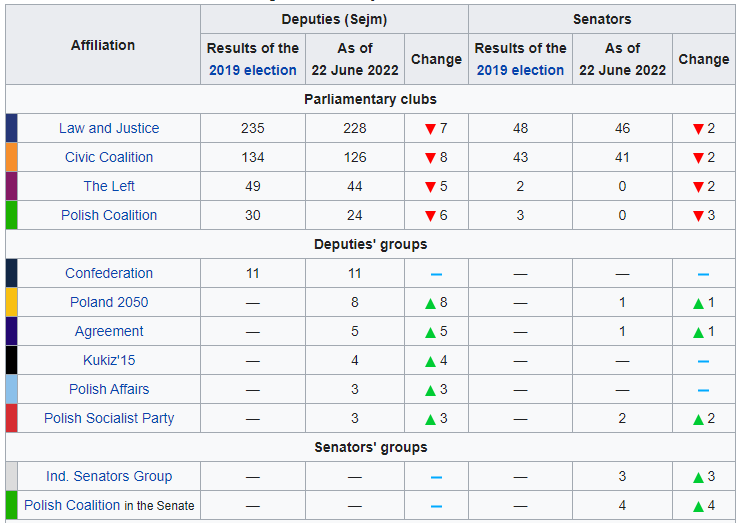
Source: https://en.wikipedia.org/wiki/Sejm
Balcerac: “Poland is being played on from several sides. On the one hand, the Russian invasion of Ukraine causes an increase in the prices of energy raw materials, and the acceleration of inflation is being exploited by the opposition. On the other hand, the European Union bureaucracy manipulated by Berlin is blocking the disbursement of EU funds to Poland; that too is being exploited by the opposition.”
“In addition, our biggest ally, the United States, is playing a double game, dreaming up plans for regime change in Warsaw. This is evident from the activity of US Ambassador Marek Brzezinski, who spends more time praising the opposition than talking to government representatives. Example: a few days before the provocation by [Civic Platform] MP Klaudia Jachira in the Sejm, Ambassador Brzezinski posed for photos with Jachira in his residence, with his arm around her.”
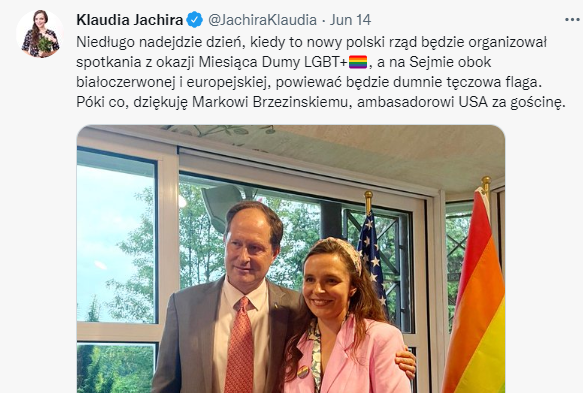
June 14 – Brzezinski embraces Jachira at his residence. Behind him is the US flag, behind her, the LGBT flag. Jachira’s tweet says: “Soon the day will come when the new Polish government will organize meetings on the occasion of the LGBT+ Pride Month, and at the Sejm, next to the [Polish] white-red and European [flags], the rainbow flag will proudly fly. In the meantime, I thank Mark Brzezinski, the U.S. ambassador, for his hospitality.”
“Everything points to the fact that billions in arms contracts for the USA, which [Defence] Minister [Mariusz] Błaszczak signs in a batch and without offsets, do not arouse American reciprocity in feelings towards the PiS government. Before the ordered military equipment will reach Poland, the country may already be ruled by a completely different team. It is symbolic that while Minister Błaszczak is sweating over the US terms in the arms contracts, the Americans are organizing high-level meetings in Washington for Rafał Trzaskowski; for example, at the end of April he met with House Speaker Nancy Pelosi.”
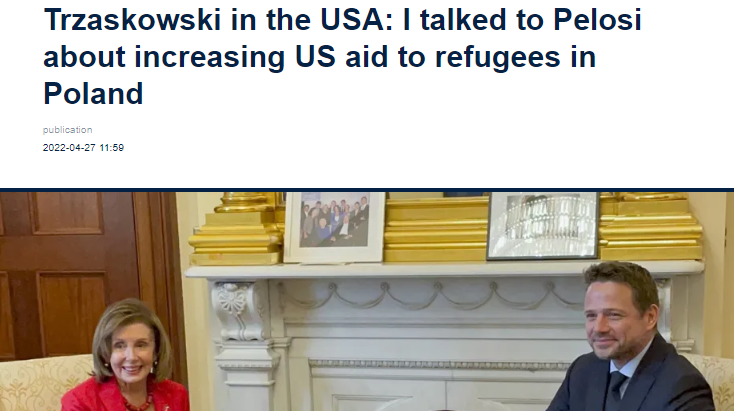
Trzaskowski in Pelosi’s office at the Capitol, April 27, 2022.
“[Security service spokesman Stanislav] Zharyn and the [Secret Services Minister Mariusz] Kamiński should learn from the recent electoral defeats of the pro-Ukrainian governments in Slovenia and Bulgaria. Prime Minister of Slovenia Janez Jansa was accompanied by Jarosław Kaczyński and Mateusz Morawiecki on their famous expedition to Kiev in mid-March. A month later, his party lost the parliamentary elections to the left. In turn, in Bulgaria, after a vote of no confidence in the Bulgarian parliament, the government of Prime Minister Kiril Petkov collapsed a few days ago. TVP Info wrote ‘the Gazprom party has overthrown the government of Bulgaria’. According to TVP Info, it is the pro-Russian president of Bulgaria Rumen Radev, ‘supporter of cooperation with Moscow’ may again be the biggest winner of the next phase of the political crisis in the country…After Slovenia and Bulgaria, the next on the Russian list will probably be Poland. And what is most interesting of all — the regime change in Poland will be carried out with the help of the American TvN station established under the supervision of Russian services. And no one even dares to write about the interference of the Kremlin.”
“So far, the PiS government does not seem to be aware of the danger. Spokesman Zharyn minimizes the Russian threat… and the government naively assumes that the 2023 election campaign conducted in the front-line country, where powerful foreign influence agencies operate, will be fair and democratic. We are faced with an impending disaster.”
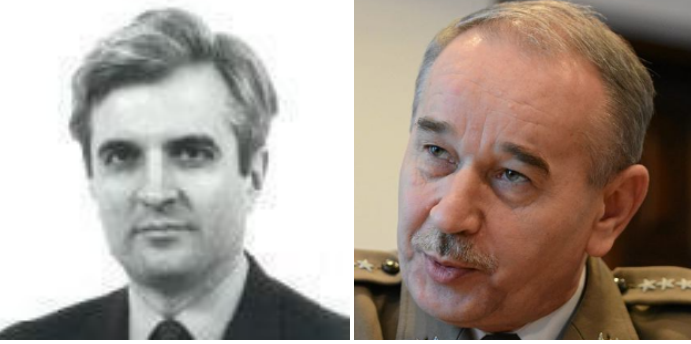
Left: Stanislas Balcerac; right, General Mieczysław Gocuł.
Also in Warsaw this week, the most widely watched public television channel, TVP Wiadomości, broadcast a lengthy interview with Polish army general Miecyslaw Gocul. He is a tank commander who rose to be chief of the Polish General Staff for two terms between 2013 and 2017. Gocul also served in staff training roles in Canada and in the UK. His only career exposure to hostile fire was in Iraq, under US command in 2003-2004.
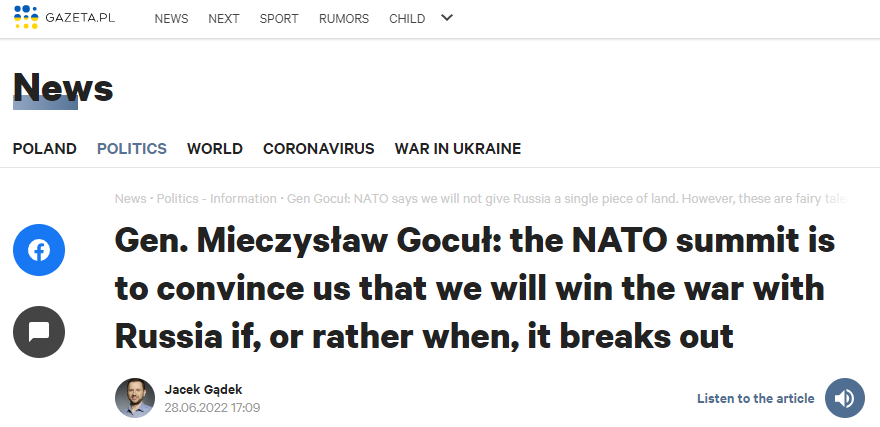
Source: https://wiadomosci.gazeta.pl/
Here is an English translation of excerpts of Gocul’s interview, published in Warsaw on June 28, as the NATO summit got under way in Madrid.
“I am very concerned that the NATO summit in Madrid is going in the wrong direction. Instead of looking for ways to win peace — because this is the essence of the problem of the eastern flank — the summit is to convince us that we will win the future war if, or rather when, it happens… First of all: NATO at the 2014 summit in Newport, by creating the Readiness Action Plan, increased the Response Force to 40,000 troops, including land, sea, air, space and cyber components. Now, in 2021-22 — because the Russians mobilized their forces for this war in October last year — we have a war. And what happened on NATO’s eastern flank? US troops arrived, but importantly, the NATO Response Force did not arrive. And yet, if Russia’s invasion of Ukraine close to our borders did not cause a reaction by the NATO Response Force, then it is necessary to ask the head of NATO whether the Alliance’s crisis response procedures have been launched at all.”
“If the Pact triggered them, after the initiating phase (conflict detection), it would be necessary to move on to the next phase — strategic assessment by the commander of the combined NATO forces in Europe. Such an assessment should be presented by the commander at a meeting of the North Atlantic Council [NAC – NATO’s most important decision-making body]. After all, this assessment ought to be a simple one. Russia deployed over 150,000 troops and launched an invasion of Ukraine. It was therefore to be expected that the NAC would share the [NATO] commander’s assessment. The next step in NATO’s crisis response should have been to use Response Options Development. But nothing like that happened. We in Poland and the Baltic states understand the threat, but the approach of other NATO states is diametrically different.”
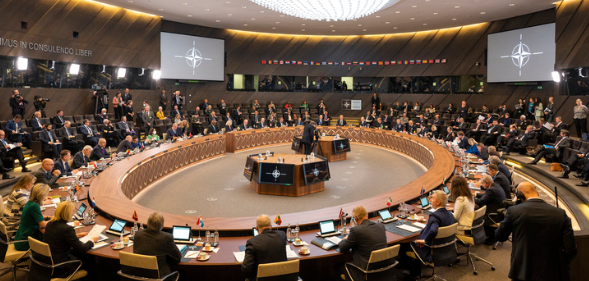
The North Atlantic Council chamber, Brussels, meeting on March 16, 2022.
“Unfortunately, even those US troops now on the eastern flank have never been placed under NATO command. Thus, the Alliance’s nerve centre or command structure has not been mobilized to coordinate the actions of the NATO Response Force, which also has not been deployed. So what if we have 40,000 men in NATO? What are the Response Forces if they haven’t moved? And have you heard that the famous NATO Spearhead [Very High Readiness Joint Task Force – VJTF] has appeared in Poland or in the Baltic States? Again, no. And yet it was created in 2014, after Russia’s war in the Donbass and the annexation of Crimea. It was supposed to react within 72 hours.”
“Question: Since 40,000 did not move, it’s likely 300,000 won’t move either, since even the Spearhead has not moved with the current state of leadership in the member states and NATO itself?”
“Gocul: Yes. It is not a question of the number of forces announced, but of the lack of a decision to deploy. It is similar with our army – the key is not whether we have 100,000 or 300,000 soldiers, but what capabilities the Polish military has and whether it has the ability to stop a Russian invasion. Let’s forget about the numbers. When humans fought with stone spears, the actual number was decisive. But not now.
You complain, and [NATO Secretary-General] Jens Stoltenberg has announced: “The NATO summit in Madrid will be groundbreaking. With a new strategic concept, we will make a fundamental change in NATO’s deterrence and defense.”
Before the NATO summit in Warsaw [in 2016]), at the Pact’s military committee, I asked Stoltenberg: what will be the guarantees for the eastern flank? He replied with a question: what else does Poland expect? I said straight out: security and prosperity, which is what the rest of us sitting at the table want.”
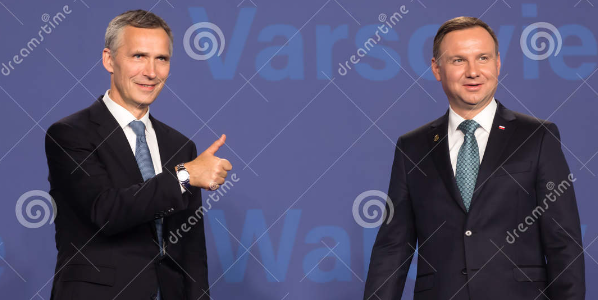
Stoltenberg and Duda at the NATO meeting in Warsaw, July 8, 2016.
“Just like then, I hear the same slogans today, such as ‘do more with less’. There are also other fine-sounding calls, but these are only political slogans calculated for a positive public reaction and minimizing costs. They do not really bring about any political and military solutions.
No breakthrough in NATO, even if there is a real risk of a war with Russia?
If Stoltenberg says it will be a turning point, it is probably only so for him. But that’s because it will be the last summit for him as the head of the Pact. The summit will definitely not be a breakthrough, because – first of all – NATO does not want to take a big step forward.
What should happen for a breakthrough to become a reality?
Let’s be honest: if there is to be a breakthrough, we should have 360 degrees of security for the Alliance – on each of its borders. And let’s also honestly answer the question: is the eastern flank safe? are Poland and the Baltic states safe? Well, we are not safe – NATO does not give us security now and the current summit in Madrid will not change this. And yet such slogans – of total security – had already been voiced at the previous summits of the Pact in Brussels, Warsaw, and Newport. They always ended up with security slogans. This time it will also be like that.
Now the tension between Russia and Lithuania is growing, because the sanctions are blocking the Kaliningrad Oblast more and more. Could this be a hotspot?
If Putin wanted to start the war further and decided to cut a corridor through the Baltics to the Kaliningrad District at the Suwałki Gap, what forces could stop him? Could the forces of Lithuania, Latvia, Estonia and Poland stop Putin? Not at all. Putin will not be stopped by the Americans, who are present on the eastern flank only in small numbers. I repeat, Russia talks and calculates only with strong countries and organizations. And NATO in our region is weak.
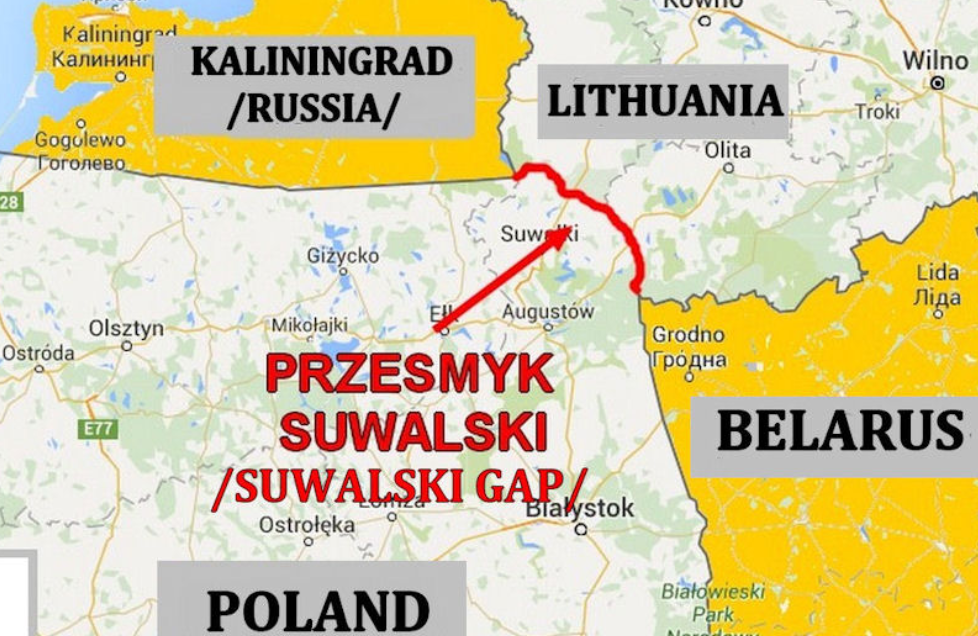
Source: https://www.globalsecurity.org/
NATO is not strong on the eastern flank, but does it have enormous potential which it does not want to transfer to our region?
NATO has military potential, but does not have the political potential to use it to build real security in our part of Europe. European leaders are not equal to the task. I don’t want to criticize individual leaders, but the role of statesmen is to make difficult but necessary decisions.
These leaders do not seem to understand that the war in Ukraine has already caused hundreds of billions of euros in damage, and will still bring trillions of damage to the entire world. It will also bring hunger and the millions of victims of hunger that Russia is blackmailing the world with. If the leaders thought seriously, they would very quickly make decisions about the forward and enhanced presence of NATO on the eastern flank, so that it could carry out specific operational tasks, which we are able to precisely define to ensure security. However, for this to be possible, a NATO division should be stationed in Poland.
After the NATO summit in Warsaw, we formally created an international division in Poland – it should be linked to the chain of command and be subordinate to the Multinational Corps Northeast in Szczecin, which is a rapid reaction corps. And this corps should be subordinate to the Allied Command of NATO’s Joint Forces in Brunssum, so that NATO would be responsible for the security of the eastern flank.
And what would result from this?
And the fact that the allied troops arriving on the eastern flank would be tied to the NATO chain of command. Today, after all, the battalion battle groups present in Poland, Lithuania, Latvia, and Estonia as a result of the NATO summit in Warsaw are not even commanded by NATO, but by the individual member states. Everything should be tight, but it isn’t.
The Estonian prime minister says: ‘Estonia [in the event of an attack by Russia] would be wiped off the map of Europe and its capital razed to the ground’, so NATO’s strategy follows the principle of ‘lose and then liberate’. And this is what it would be like in the event of the Russian invasion of the Baltic states?
This, unfortunately, is true. But let’s start with the basic thing: what is the definition of security? It is the freedom to choose the path of development of the country. After all, what we have today on the eastern flank – in Poland, Lithuania, Latvia, Estonia – is a contradiction of security. There is no free development; there are a lot of restrictions; there is a huge pressure to increase defense spending. And if there is no security, it means that NATO is not meeting the goals set out in the Washington Treaty, so NATO is not a strategic concept today…
And in your opinion today is it fiction?
If Stoltenberg is reading correctly the Treaty and the Charter of the United Nations, to which the preamble to the Treaty refers, then he should be aware that NATO was not created to reflect NATO territory. And today it would be forced to do so, because it is not able to defend the territory not only of Estonia, but also of Poland. It must be emphasized that NATO was created to defend NATO territory – to prevent the conflict from escalating and, as a result, from taking over at least part of NATO territory by the enemy.
However, there were already a great many declarations that NATO would defend every scrap of the territory of a member state. In fact, it is impossible?
Today, NATO is actually saying we will not give up any land to Russia. However, this is a fairy tale, and Putin probably scoffs at it. Because what did NATO – apart from the rhetoric and Stoltenberg’s many meetings — do about the war in Ukraine? NATO has a Spearhead – it did not send it. NATO has a Response Force of 40,000 troops — they didn’t move. NATO has a command system – it has not moved. And if NATO wants to increase its Response Force to 300,000 or whatever number someone thinks would be right, that sounds like a joke, because the 300,000 wouldn’t move either.
One should also pay attention to the condition of our army, which would also have trouble moving. The operational units are stripped by the territorial defense forces. We have a shortage of officer cadres, problems with mobilization, and a broken crisis response system. We have announcements of huge purchases of weapons and the propaganda creation of a new division, but I dare to suspect that we are not able to deploy as many highly completed units as we declare for the NATO table of forces.
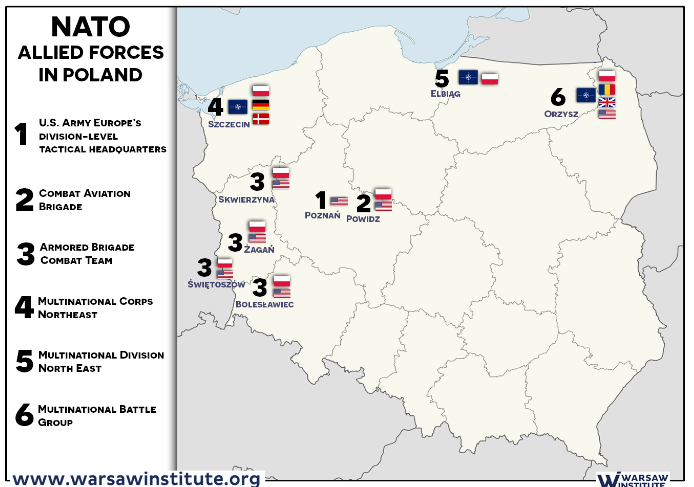
Source: https://warsawinstitute.org/
You paint a dramatic picture of the lack of determination and strength of NATO and the Polish army.
…. At the plenary session of the NATO military committee – before the summit in Warsaw – I argued to the Americans: if you want a NATO Response Force in Spain, they will sleep in their shoes and with rifles in their hands, and they will come to Poland too late anyway. I proposed: the forward presence of these troops on the eastern flanks is needed, so that the soldiers sleep in their pajamas, train and relax, but if there is a threat, they will get dressed in one day, have time to eat, get their equipment and go to the front.
It took Putin over a year to collect 150,000 soldiers on the border with Ukraine – maybe this is the time to transfer NATO troops from Spain or Italy to the eastern flank?
I will answer without violating the official secrecy. There once was an incident in the Baltic Sea when over 30 Russian ships suddenly appeared on it [Exercise Ocean Shield 2019 — https://thebarentsobserver.com/en/security/2021/07/northern-fleet-warships-will-conduct-tactical-exercises-around-scandinavia . Total surprise. And yet ships at sea are not a tank that can be hidden in the forest. If more than thirty such ships went to sea and NATO knew nothing about it, will NATO be able to react quickly enough when Putin really wants to attack?…
So are NATO guarantees mostly on paper and there’s little response capacity?
If anyone says that by increasing the declared number of soldiers of the NATO Response Force to 300,000 and also that we want to increase the size of our own army to 300,000, we will ensure our own safety, that’s talking nonsense. If someone says that the Polish army will be so strong that it will win a war with Russia, that is also gibberish. In fact, even with these numbers of NATO forces on the eastern flank and of our army, the Russians will demolish the country.
I am very concerned that the NATO summit in Madrid is going in the wrong direction. Instead of looking for ways to win peace, because this is the crux of the eastern flank problem, the summit is to convince us that we will win the future war if, or rather when, it occurs. This rhetoric ended as we see it in Ukraine.
However, it is to increase support for the eastern flank.
But it will only cement the status quo. And the status quo is that NATO has done nothing to prevent a future war between Russia and NATO on the eastern flank.”


